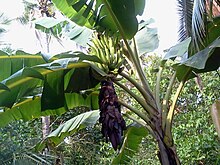In regions such as North America and Europe, Musa fruits offered for sale can be divided into "bananas" and "plantains", based on their intended use as food. Thus the banana producer and distributor Chiquita produces publicity material for the American market which says that "a plantain is not a banana". The stated differences are that plantains are more starchy and less sweet; they are eaten cooked rather than raw; they have thicker skin, which may be green, yellow or black; and they can be used at any stage of ripeness.[34] Linnaeus made the same distinction between plantains and bananas when first naming two "species" of Musa.[35]Members of the "plantain subgroup" of banana cultivars, most important as food in West Africa and Latin America, correspond to the Chiquita description, having long pointed fruit. They are described by Ploetz et al. as "true" plantains, distinct from other cooking bananas.[36] The cooking bananas of East Africa belong to a different group, the East African Highland bananas,[12] so would not qualify as "true" plantains on this definition.
An alternative approach divides bananas into dessert bananas and cooking bananas, with plantains being one of the subgroups of cooking bananas.[37] Triploid cultivars derived solely from M. acuminata are examples of "dessert bananas", whereas triploid cultivars derived from the hybrid between M. acuminata and M. balbinosa (in particular the plantain subgroup of the AAB Group) are "plantains".[38][39] Small farmers in Colombia grow a much wider range of cultivars than large commercial plantations. A study of these cultivars showed that they could be placed into at least three groups based on their characteristics: dessert bananas, non-plantain cooking bananas, and plantains, although there were overlaps between dessert and cooking bananas.[40]
In Southeast Asia – the center of diversity for bananas, both wild and cultivated – the distinction between "bananas" and "plantains" does not work, according to Valmayor et al. Many bananas are used both raw and cooked. There are starchy cooking bananas which are smaller than those eaten raw. The range of colors, sizes and shapes is far wider than in those grown or sold in Africa, Europe or the Americas.[35] Southeast Asian languages do not make the distinction between "bananas" and "plantains" that is made in English (and Spanish). Thus both Cavendish cultivars, the classic yellow dessert bananas, and Saba cultivars, used mainly for cooking, are called pisang inMalaysia and Indonesia, kluai in Thailand and chuoi in Vietnam.[41] Fe'i bananas, grown and eaten in the islands of the Pacific, are derived from entirely different wild species than traditional bananas and plantains. Most Fe'i bananas are cooked, but Karat bananas, which are short and squat with bright red skins, very different from the usual yellow dessert bananas, are eaten raw.[42]
In summary, in commerce in Europe and the Americas (although not in small-scale cultivation), it is possible to distinguish between "bananas", which are eaten raw, and "plantains", which are cooked. In other regions of the world, particularly India, Southeast Asia and the islands of the Pacific, there are many more kinds of banana and the two-fold distinction is not useful and not made in local languages. Plantains are one of many kinds of cooking bananas, which are not always distinct from dessert bananas.



